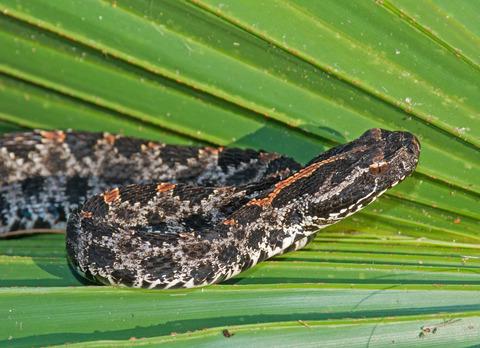当前位置:
X-MOL 学术
›
Funct. Ecol.
›
论文详情
Our official English website, www.x-mol.net, welcomes your
feedback! (Note: you will need to create a separate account there.)
An emerging fungal pathogen is associated with increased resting metabolic rate and total evaporative water loss rate in a winter‐active snake
Functional Ecology ( IF 4.6 ) Pub Date : 2019-12-18 , DOI: 10.1111/1365-2435.13487 Joseph Agugliaro 1 , Craig M. Lind 2 , Jeffrey M. Lorch 3 , Terence M. Farrell 4
Functional Ecology ( IF 4.6 ) Pub Date : 2019-12-18 , DOI: 10.1111/1365-2435.13487 Joseph Agugliaro 1 , Craig M. Lind 2 , Jeffrey M. Lorch 3 , Terence M. Farrell 4
Affiliation

|
Energy allocation trade‐offs associated with mounting metabolically costly immune responses may serve as sublethal mechanisms by which pathogens reduce host fitness. The emergence of cutaneous fungal pathogens, which invade the skin of their host and have the potential to disturb energy and water balance, highlight the importance of host physiology in determining individual‐ and population‐level effects of disease. Snake fungal disease (SFD, ophidiomycosis), caused by the fungal pathogen Ophidiomyces ophiodiicola (Oo), is an emerging disease afflicting wild snake populations throughout eastern North America. Emaciation and dehydration are phenotypic correlates of SFD, but it is unknown if such declines in host condition occur via effects of Oo infection on host physiology (i.e. increased rates of metabolism and evaporative water loss respectively). We used flow‐through respirometry to assess the energetic and hydric consequences of natural Oo infection in winter‐active pygmy rattlesnakes Sistrurus miliarius. We measured resting metabolic rate (CO₂ production rate) and total evaporative water loss rate of winter‐acclimatized S. miliarius as a function of SFD status and acute temperature (17, 25 and 32°C). We also used regression models characterizing individual variation in the thermal‐sensitivity of resting metabolic rate to predict the theoretical effects of behavioural fever on daily resting CO₂ production by free‐ranging S. miliarius with SFD in winter. Natural infection by Oo was associated with significant increases in resting metabolic rate (30%–45%) and total evaporative water loss rate (30%–40%) across all measurement temperatures. Under simulated scenarios of behavioural fever, Oo infection was predicted to increase daily resting CO₂ production rate by 58%–102%. Our results are consistent with the hypothesis that the immune response to Oo infection is energetically costly and may contribute to declining host condition. Our modelling efforts combining the cumulative effects of increased immune activity and increased body temperature on metabolism represent a novel approach in quantifying the total daily energetic cost of infection in ectothermic vertebrates undergoing behavioural fever. A free Plain Language Summary can be found within the Supporting Information of this article.
中文翻译:

一种新出现的真菌病原体与冬季活跃的蛇的静息代谢率和总蒸发失水率增加有关
与增加代谢成本高的免疫反应相关的能量分配权衡可能是病原体降低宿主适应性的亚致死机制。侵入宿主皮肤并有可能扰乱能量和水平衡的皮肤真菌病原体的出现突显了宿主生理学在确定疾病对个体和群体水平影响方面的重要性。由真菌病原体 Ophidiomyces ophiodiicola (Oo) 引起的蛇真菌病 (SFD, ophidiomycosis) 是一种新出现的疾病,它困扰着整个北美东部的野生蛇种群。消瘦和脱水是 SFD 的表型相关性,但不清楚宿主条件的这种下降是否通过 Oo 感染对宿主生理学的影响(即分别增加代谢率和蒸发失水率)发生。我们使用流通式呼吸测量法来评估冬季活跃的侏儒响尾蛇 Sistrurus miliarius 中自然 Oo 感染的能量和水分后果。我们测量了冬季适应的粟鲭的静息代谢率(CO 2 产生率)和总蒸发失水率,作为 SFD 状态和急性温度(17、25 和 32°C)的函数。我们还使用回归模型表征静息代谢率热敏感性的个体差异,以预测行为发烧对冬季自由放养的 S. miliarius 与 SFD 的每日静息二氧化碳产生的理论影响。Oo 的自然感染与所有测量温度下静息代谢率 (30%–45%) 和总蒸发失水率 (30%–40%) 的显着增加有关。在行为发烧的模拟场景下,预计 Oo 感染会使每日静息二氧化碳产生率提高 58%–102%。我们的结果与对 Oo 感染的免疫反应在能量上成本高昂并可能导致宿主条件下降的假设一致。我们的建模工作结合了增加的免疫活动和增加的体温对新陈代谢的累积影响,代表了一种量化经历行为发烧的变温脊椎动物感染的每日总能量成本的新方法。可以在本文的支持信息中找到免费的普通语言摘要。我们的建模工作结合了增加的免疫活动和增加的体温对新陈代谢的累积影响,代表了一种量化经历行为发烧的变温脊椎动物感染的每日总能量成本的新方法。可以在本文的支持信息中找到免费的普通语言摘要。我们的建模工作结合了增加的免疫活动和增加的体温对新陈代谢的累积影响,代表了一种量化经历行为发烧的变温脊椎动物感染的每日总能量成本的新方法。可以在本文的支持信息中找到免费的普通语言摘要。
更新日期:2019-12-18
中文翻译:

一种新出现的真菌病原体与冬季活跃的蛇的静息代谢率和总蒸发失水率增加有关
与增加代谢成本高的免疫反应相关的能量分配权衡可能是病原体降低宿主适应性的亚致死机制。侵入宿主皮肤并有可能扰乱能量和水平衡的皮肤真菌病原体的出现突显了宿主生理学在确定疾病对个体和群体水平影响方面的重要性。由真菌病原体 Ophidiomyces ophiodiicola (Oo) 引起的蛇真菌病 (SFD, ophidiomycosis) 是一种新出现的疾病,它困扰着整个北美东部的野生蛇种群。消瘦和脱水是 SFD 的表型相关性,但不清楚宿主条件的这种下降是否通过 Oo 感染对宿主生理学的影响(即分别增加代谢率和蒸发失水率)发生。我们使用流通式呼吸测量法来评估冬季活跃的侏儒响尾蛇 Sistrurus miliarius 中自然 Oo 感染的能量和水分后果。我们测量了冬季适应的粟鲭的静息代谢率(CO 2 产生率)和总蒸发失水率,作为 SFD 状态和急性温度(17、25 和 32°C)的函数。我们还使用回归模型表征静息代谢率热敏感性的个体差异,以预测行为发烧对冬季自由放养的 S. miliarius 与 SFD 的每日静息二氧化碳产生的理论影响。Oo 的自然感染与所有测量温度下静息代谢率 (30%–45%) 和总蒸发失水率 (30%–40%) 的显着增加有关。在行为发烧的模拟场景下,预计 Oo 感染会使每日静息二氧化碳产生率提高 58%–102%。我们的结果与对 Oo 感染的免疫反应在能量上成本高昂并可能导致宿主条件下降的假设一致。我们的建模工作结合了增加的免疫活动和增加的体温对新陈代谢的累积影响,代表了一种量化经历行为发烧的变温脊椎动物感染的每日总能量成本的新方法。可以在本文的支持信息中找到免费的普通语言摘要。我们的建模工作结合了增加的免疫活动和增加的体温对新陈代谢的累积影响,代表了一种量化经历行为发烧的变温脊椎动物感染的每日总能量成本的新方法。可以在本文的支持信息中找到免费的普通语言摘要。我们的建模工作结合了增加的免疫活动和增加的体温对新陈代谢的累积影响,代表了一种量化经历行为发烧的变温脊椎动物感染的每日总能量成本的新方法。可以在本文的支持信息中找到免费的普通语言摘要。











































 京公网安备 11010802027423号
京公网安备 11010802027423号